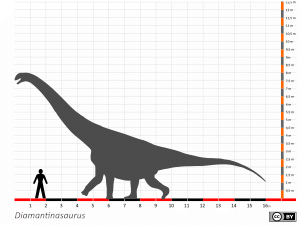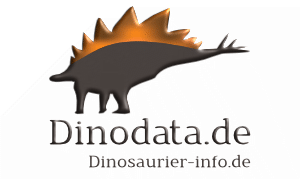
Hocknull, White, Tischler, Cook, Calleja, Sloan, Elliott, 2009
Klassifizierung: Lithostrotia
Fortbewegung: quadruped
Ernährung: herbivor
Bedeutung des Namen: Echse vom (Fluß) Diamantina
Die Beschreibung des Diamantinasaurus basiert auf den Holotypus mit der Bezeichnung AODL 603, einem Teilskelett, bestehend aus dem rechten Schulterblatt, dem Brustbein (Sternum), Teilen der Vorderbeine, Teilen der Hinterbeine ohne Füße sowie einigen Hüft- und Rippenknochen. Diamantinasaurus besaß eine für einen Titanosaurier ungewöhnliche Daumenkralle.
Die Typusart wurde im Jahr 2009 von Scott Hocknull und seinen Kollegen beschrieben und Diamantinasaurus matildae genannt, das Art-Epitheton matildae in Anlehnung an das australische Volkslied "Waltzing Matilda", welches von Andrew Barton Paterson im nahe gelegenen Winton geschrieben wurde. Dieser Pflanzenfresser wird als ein untersetzter Titanosaurier mit etwa 16 m Länge und einem Gewicht von ungefähr 20 Tonnen beschrieben. Die Knochen von Diamantinasaurus lassen sich von denen des mit ihm entdeckten Titanosauriers Wintonotitan gut unterscheiden, weil diese wesentlich robuster sind. Zur Flora der Winton-Formation, in der dieser Sauropode entdeckt wurde, gehörten Farne, Ginkgos, Gymnospermen und Angiospermen. Vermutlich ernährte sich Diamantinasaurus von einigen dieser Pflanzen.
Höhe: 3,5 m
Länge: 16 m
Gewicht: 15 to
Holotyp: AODL 603
Fundort: Winton Formation, Triangle Paddock’, Elderslie, Station Queensland, Australien

© Dinodata.de

© Hocknull et al.

© Raul Lunia

© Elena Marian
Weitere Informationen
A juvenile Diamantinasaurus matildae (Dinosauria: Titanosauria) from the Upper Cretaceous Winton Formation of Queensland, Australia, with implications for sauropod ontogeny / Samantha L. Rigby, Stephen F. Poropat, Philip D. Mannion, Adele H. Pentland, Trish Sloan, Steven J. Rumbold, Carlin B. Webster, David A. Elliott, 2022 / Journal of Vertebrate Paleontology, e2047991, https://doi.org/10.1080/02724634.2021.2047991 /
/ Samantha L. Rigby, Stephen F. Poropat, Philip D. Mannion, Adele H. Pentland, Trish Sloan, Steven J. Rumbold, Carlin B. Webster, David A. Elliott, 2022 / Journal of Vertebrate Paleontology, e2047991, https://doi.org/10.1080/02724634.2021.2047991 / PDF
PDF
A nearly complete skull of the sauropod dinosaur Diamantinasaurus matildae from the Upper Cretaceous Winton Formation of Australia and implications for the early evolution of titanosaurs  / Stephen F. Poropat, Philip D. Mannion, Samantha L. Rigby, Ruairidh J. Duncan, Adele H. Pentland, Joseph J. Bevitt, Trish Sloan, David A. Elliott, 2023 / Royal Society Open Science, Volume 10, Issue 4, https://doi.org/10.1098/rsos.221618 /
/ Stephen F. Poropat, Philip D. Mannion, Samantha L. Rigby, Ruairidh J. Duncan, Adele H. Pentland, Joseph J. Bevitt, Trish Sloan, David A. Elliott, 2023 / Royal Society Open Science, Volume 10, Issue 4, https://doi.org/10.1098/rsos.221618 /  PDF
PDF
New Mid-Cretaceous (Latest Albian) Dinosaurs from Winton, Queensland, Australia / Scott A. Hocknull, Matt A. White, Travis R. Tischler, Alex G. Cook, Naomi D. Calleja, Trish Sloan, David A. Elliott, 2009 / PLoS ONE 4(7): e6190. doi:10.1371/journal.pone.0006190 /
/ Scott A. Hocknull, Matt A. White, Travis R. Tischler, Alex G. Cook, Naomi D. Calleja, Trish Sloan, David A. Elliott, 2009 / PLoS ONE 4(7): e6190. doi:10.1371/journal.pone.0006190 /![]() PDF
PDF
New Australian sauropods shed light on Cretaceous dinosaur palaeobiogeography / Stephen F. Poropat, Philip D. Mannion, Paul Upchurch, Scott A. Hocknull, Benjamin P. Kear, Martin Kundrát, Travis R. Tischler, Trish Sloan, George H. K. Sinapius, Judy A. Elliott, David A. Elliott, 2016 / Scientific Reports 6, Article number: 34467 (2016). doi:10.1038/srep34467 /
/ Stephen F. Poropat, Philip D. Mannion, Paul Upchurch, Scott A. Hocknull, Benjamin P. Kear, Martin Kundrát, Travis R. Tischler, Trish Sloan, George H. K. Sinapius, Judy A. Elliott, David A. Elliott, 2016 / Scientific Reports 6, Article number: 34467 (2016). doi:10.1038/srep34467 / PDF / ergänzende Informationen:
PDF / ergänzende Informationen:  PDF
PDF
Second specimen of the Late Cretaceous Australian sauropod dinosaur Diamantinasaurus matildae provides new anatomical information on the skull and neck of early titanosaurs / Stephen F Poropat, Martin Kundrát, Philip D Mannion, Paul Upchurch, Travis R Tischler, David A Elliott, 2021 / Zoological Journal of the Linnean Society, zlaa173, https://doi.org/10.1093/zoolinnean/zlaa173
/ Stephen F Poropat, Martin Kundrát, Philip D Mannion, Paul Upchurch, Travis R Tischler, David A Elliott, 2021 / Zoological Journal of the Linnean Society, zlaa173, https://doi.org/10.1093/zoolinnean/zlaa173
- - - - -
Bildlizenzen
Größenvergleich / © Dinodata.de:
 Creative Commons 4.0 International (CC BY 4.0)
Creative Commons 4.0 International (CC BY 4.0)
Chevronknochen des Diamantinasaurus / © Hocknull et al.:
 Creative Commons 4.0 International (CC BY 4.0)
Creative Commons 4.0 International (CC BY 4.0)
Diamantinasaurus / © Elena Marian:
 Creative Commons 4.0 International (CC BY 4.0)
Creative Commons 4.0 International (CC BY 4.0)
- - - - -
Grafiken und Illustrationen von Raul Lunia



